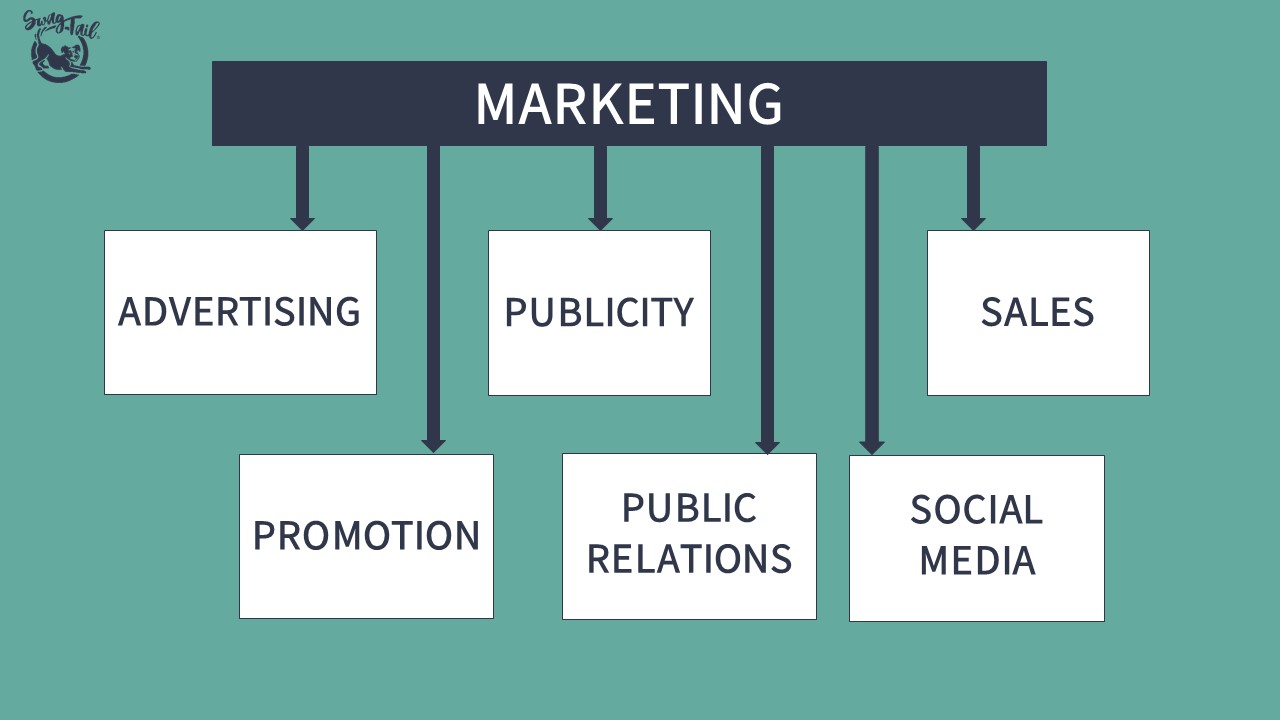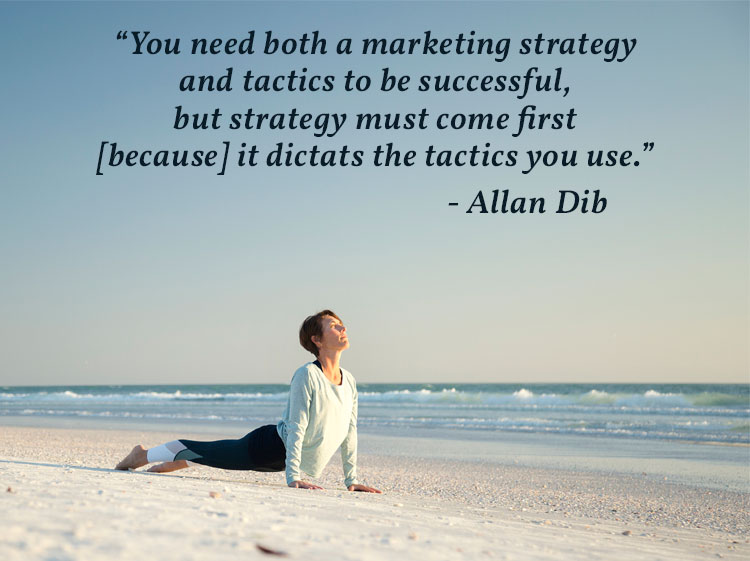 Marketing is an often misunderstood term, and thus a very underutilized approach to get more clients and better serve your existing ones. That’s where this blog post comes in! Today, you’ll discover the essential elements of a marketing strategy. Plus, you’ll learn the basics of how to build one that fits your unique skills, time commitments and budget. This is true whether you’re an independent yoga teacher or studio owner.
Marketing is an often misunderstood term, and thus a very underutilized approach to get more clients and better serve your existing ones. That’s where this blog post comes in! Today, you’ll discover the essential elements of a marketing strategy. Plus, you’ll learn the basics of how to build one that fits your unique skills, time commitments and budget. This is true whether you’re an independent yoga teacher or studio owner.
This is incredibly relevant in today’s marketplace. And here’s why.
Just yesterday I had a conversation with a dear friend and seasoned yoga professional who is based out of Northern California. She expressed concern about what the future of teaching yoga looks like. Is the yoga industry going to entirely shift online? Will students want to return to a studio setting? And how do teachers best prepare now for those changes?
Yes, the future is unknown. And while each of those questions require lengthy answers (many of which I’ll cover in future articles here at Swagtail), I found deep comfort in knowing this truth:
No matter the format you use to teach yoga, the basics of your marketing strategy are the same. This means that you can continue to deliberately build your community now. Use the insights of this article to confidently get started today. And if you want to go deeper on this topic, check out our latest session of Yoga Business Academy.
Photo Credit: Ember and Earth
WHAT IS A MARKETING STRATEGY?
As with most things in life, it’s much easier to understand a concept if you see the big picture first. So let’s start with a basic definition of marketing.
“Marketing is the plan you put in place to get your ideal client to know you, like you, and trust you. It’s also how you communicate with your existing clients to serve them to the best of your ability.”
Now marketing is often used in vague terms. Or the term marketing is used interchangeably with other phrases such as advertising or branding. And while these ideas are associated with marketing, they are not one and the same.
Marketing is the formula or blueprint you use to get and retain customers. Then the tactics you use within that marketing plan are the vehicle through which you share your message.

MARKETING IS A BIG PICTURE PLAN
Marketing is the big picture plan you have in place. It’s like a broad umbrella that covers–or encompasses–all of the specific methods you use to achieve your goal. Here are just a few of tactics that get used within a marketing strategy:
Advertising
First you have advertising. This is how you proudly announce what you offer as a yoga teacher. Perhaps you place an image in the local health and wellness paper about your new studio. Or, maybe you place flyers about your upcoming workshops on bulletin boards at the local co-op. You might even purchase ads on social media that introduce you (and your yoga business) to new clients.
Promotion
Promotion is all about public attention. Let’s say you are going to shop at the farmer’s market, and you wear a sweatshirt that has your business logo and name on it; that’s promotion. Or, you might even put a sandwich board out on the street to catch the attention of pedestrians passing by.
Publicity
Publicity is media attention, so if you started a beach clean up in your area as a yoga off of the mat campaign, someone in your local newspaper would write about you and bring attention to your company.
Public Relations
Public relations is the aspect of your marketing strategy that can be the most difficult to manufacture or control. This is when someone of standing or influence notices you, and thus increases the favorability of your brand in the public eye. For example, let’s say the mayor delighted about your beach clean up and positive impact on the community. Then he shares it on the local news. That’s public relations at work.
Social Media
Social media marketing is such a powerful way to connect with others. You can use numerous platforms to learn about those you want to serve as well as collaborate with like-minded professionals. And, as I just mentioned above, you can advertise on these channels to expose potential clients to your brand.

START WITH A PLAN
Whether you are teaching yoga virtually, or you go back to working with clients face-to-face, you want to craft a custom marketing strategy. Said another way, you want to have a big picture plan of how the methods I just mentioned above will work together to grow your yoga business.
This concept is very similar to that of construction. For example, right now we are remodeling our master bathroom. (For those of you long-time readers, this is a different project than one we undertook two years ago–one that had me listening to business podcasts while peeling wallpaper and painting).
Anyway, it all started as a backed up shower and toilet. This led to replacing the pipe under the house and tearing out the entire floor to make that possible.
Before taking action, we met with a contractor. We drew the schematics for what we wanted, which included tearing down a wall, changing countertops, and adding new sections of glass for the shower. This plan was like the marketing strategy. All of the big picture items were in place before the work got started.
Then, with the blueprint in place, we put together a materials list. We hired tile setters, granite experts, and plumbers. They are the geniuses who actually transform our ideas into reality.
Marketing is the Same!
You want to put a strategy in place. Your marketing plan is the blueprint for how you get, and retain customers. Then once you have the strategy, decide which tactics to use moving forward to best utilize your time, energy, resources to meet your goals.
Professionals have plans. Doctors follow treatment plans and airline pilots follow flight plans. They rarely go off of gut instinct.
And you’re a Yoga Professional who can craft a marketing plan to help you start and develop an incredible yoga business. Then, you can use your heightened intuition to modify your approach as you go.

Photo Credit: Ember and Earth
SET THE FOUNDATION
In order to decide which tactics to use as part of your marketing plan (and how often to use them), you want to first have the following items in play.
An Ideal Client
One of the biggest mistakes that yoga teachers make is that they believe they have to serve everyone. Yes, it’s true that yoga can benefit everyone. Yet that doesn’t mean that your yoga skills and passions will match the needs of all other people. In fact, if you try to do this, you’ll get burned out and frustrated.
Instead, think of how you have been positively transformed by the practice. Consider how your specific yoga training and unique life experiences can blend perfectly to serve a select few. That minority becomes your ideal target market, and you want to develop a marketing plan that will introduce you to–and help you serve–that small group!
A Clear Message
Now that you know who you can best serve, you want to create a clear message so they can hear you. How do you do this?
First, you start by understanding the biggest problem faced by your ideal client. What gets them frustrated? What causes them pain? How are they held back from living their best life.
Then, you acknowledge how you–and your yoga business–can help solve their problem. How will yoga alleviate that pain? In what ways will yoga give them hope, confidence, a new way of experiencing life? And which aspects of the yoga practice will best do this?
 If you’re not sure about this right now, stop and think about who you work with today.
If you’re not sure about this right now, stop and think about who you work with today.
- Are there common issues you see for most of your students?
- What have your students said about their own positive growth?
- How have their lives changed for the better by working with you?
You can use their stories of transformation to encourage new students to give yoga a try! And sharing these stories also validates the experience of your existing students. This is a total win-win-win! Plus all of this becomes some of the best material for your advertising, website copy, and other promotional material.
Strong Personal Knowing
What I mean by this is that you want to know your own strengths, habits, and preferences before selecting the tactics for your marketing strategy. If you enjoy creating beautiful graphics and can design your own visual ads; awesome! Use that gift!
Or, if you’ve got a huge network of friends that can help spread the word about an upcoming event, honor that too. Your marketing plan can align with the great momentum you already have going in your life, and thus be a seamless part of how you run your yoga business.
A Realistic Budget
Resources are the key elements that help your yoga business continue to grow. This comes in the form of time and money. So, take a look at your current commitments through a realistic lens.
- How much time do I have to develop a marketing strategy now?
- And how much time will it take to implement each of the tactics above? Which of those tactics can I realistically commit to starting now? Or using in the next 3-6-9 months?
- What is my budget?
- Which methods mentioned above best fit within my current budget?
WORD-OF-MOUTH MARKETING
What I didn’t list as a marketing tactics above is word-of-mouth marketing. I’ve heard this referred to as “passive marketing” and I seriously laughed out loud. This really couldn’t be further from the truth.
Word of mouth marketing is where clients sing your praises. They tell others about how great you are and how your incredible services have changed their lives. It’s their voice doing the talking, that’s true. So you’re technically not doing the work.
However, each time you craft an amazing yoga experience, you are enhancing trust with your existing clients. Every time you show up consistently, whether it be in person or online, you build stronger bonds with your students. And every time you further your yoga education and share your learning with your community, you’re doing marketing.
Only this marketing is the behind the scenes strategy you have in place to serve your existing clients. Remember, marketing is how you get new clients and how you communicate with those already in your sphere of influence.
So ask yourself:
- What actions do I take regularly to give my best to my students?
- How often do I express appreciation for my clients?
- In what ways do I collect positive stories of transformation?
- How do I validate the experience of my students?
- And do I make it easy for them to share their success with others?
PUTTING IT TOGETHER
A marketing strategy is the big-picture plan you have in place to meet potential clients. It’s how you tell them about what you offer and share the positive transformation that can occur in their lives by working with you. What often gets overlooked in a marketing plan is the deliberate steps you take on a daily basis to uplift your existing clients and give them your very best (so they naturally want to share your greatness with others).
Then, once you have that big picture in place, you can select the best tactics (or methods) to bring your ideas to life.
Take Action Now:
- Use this questionnaire to start crafting a marketing strategy that fits your target market, personal strengths and business budget.
- Read a marketing book, such as Marketing Made Simple or The 1-Page Marketing Plan.
- Join Yoga Business Academy to dive more deeply into how to craft a marketing strategy today.
- If you’re entirely new to teaching yoga, and want to learn how to build your yoga business from the ground up, check out our Launch your Yoga Business course. It’s set to go live in just a few weeks’ time.








Leave A Comment